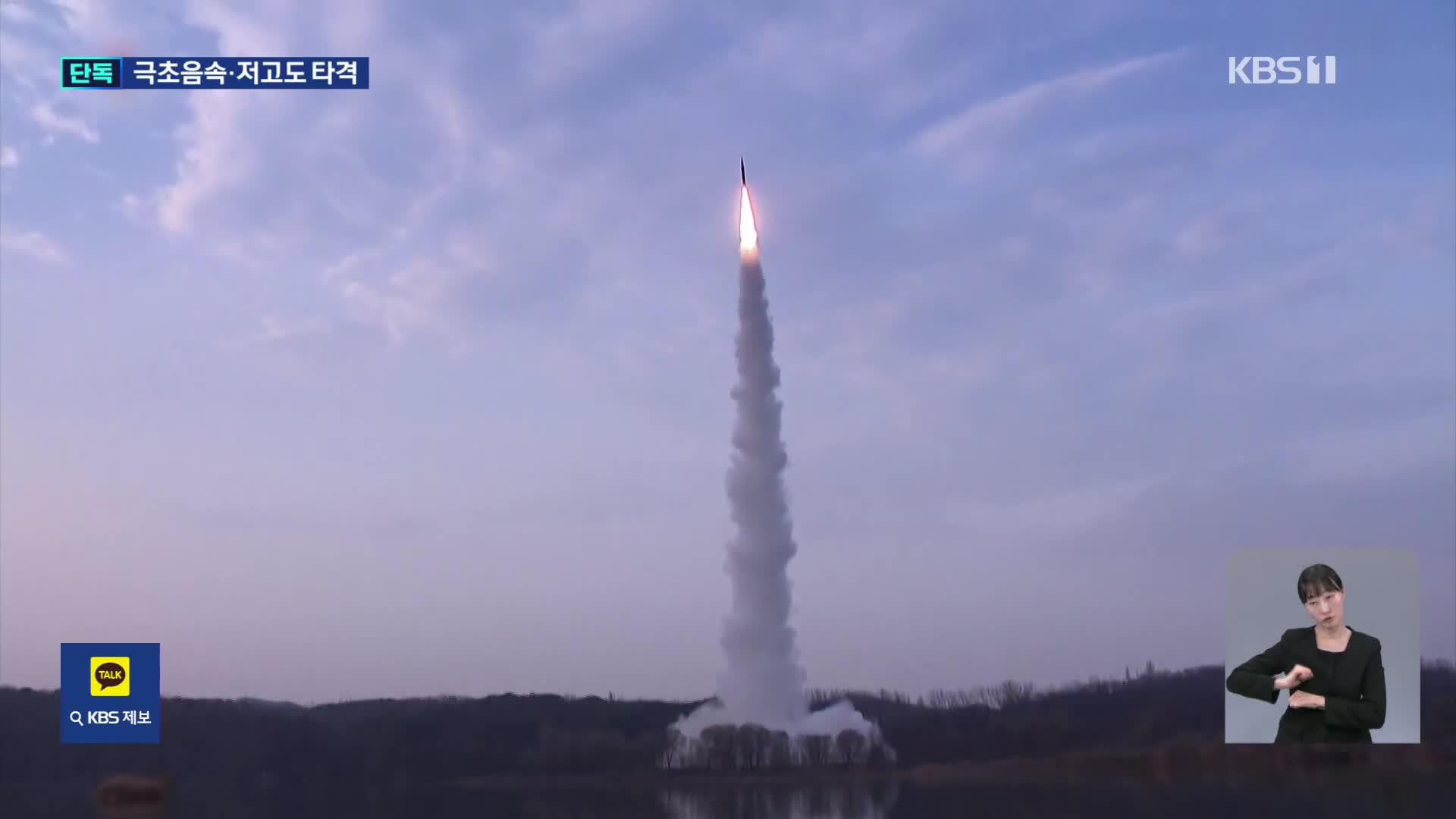[Exclusive] N. Korea tests improved hypersonic missile
입력 2025.01.07 (00:42)
읽어주기 기능은 크롬기반의
브라우저에서만 사용하실 수 있습니다.
[Anchor]
North Korea has reported that the ballistic missile launched towards the East Sea today (Jan. 6) is an improved hypersonic missile compared to the test launches conducted last year.
Specifically, this missile reached a relatively low altitude of about 100 kilometers and achieved speeds of up to eleven times the speed of sound, and it is understood that it also performed stage separation.
Reporter Kim Yong-jun has the exclusive coverage.
[Report]
North Korea launched one missile into the East Sea around noon today.
This is the first provocation of the year.
Military authorities assessed that this missile is equipped with a medium-range engine capable of flying between 3,000 km and 5,500 km.
However, the actual flight distance was 1,100 km.
It was launched from the Pyongyang area and fell into the East Sea.
There is a possibility that they adjusted the fuel amount to control the level of provocation so that the missile would not approach the U.S. territory of Guam.
However, military authorities are focusing on the solid-fuel-based improved hypersonic missile.
Hypersonic missiles separate stages after launch and glide at low altitudes, making it difficult to detect and intercept them.
According to KBS's investigation, this missile did experience stage separation and reached a maximum altitude of only about 100 km, which is very low compared to existing medium-range ballistic missiles.
It was also confirmed that it flew for 6 minutes at a speed exceeding Mach 11, which is eleven times the speed of sound.
[Choi Hyun-guk/Former Vice Chairman of the Joint Chiefs of Staff: "The high speed minimizes response time for our defense systems, making it extremely challenging for interception systems to operate during the missile's terminal phase."
North Korea also conducted three test launches of a new hypersonic missile last year, but they had short ranges or exploded in mid-air.
The military is also reported to have detected signs of additional missile launches being prepared, indicating that North Korea seems to be trying to showcase its presence through provocations ahead of the U.S. presidential inauguration.
This is KBS News, Kim Yong-jun.
North Korea has reported that the ballistic missile launched towards the East Sea today (Jan. 6) is an improved hypersonic missile compared to the test launches conducted last year.
Specifically, this missile reached a relatively low altitude of about 100 kilometers and achieved speeds of up to eleven times the speed of sound, and it is understood that it also performed stage separation.
Reporter Kim Yong-jun has the exclusive coverage.
[Report]
North Korea launched one missile into the East Sea around noon today.
This is the first provocation of the year.
Military authorities assessed that this missile is equipped with a medium-range engine capable of flying between 3,000 km and 5,500 km.
However, the actual flight distance was 1,100 km.
It was launched from the Pyongyang area and fell into the East Sea.
There is a possibility that they adjusted the fuel amount to control the level of provocation so that the missile would not approach the U.S. territory of Guam.
However, military authorities are focusing on the solid-fuel-based improved hypersonic missile.
Hypersonic missiles separate stages after launch and glide at low altitudes, making it difficult to detect and intercept them.
According to KBS's investigation, this missile did experience stage separation and reached a maximum altitude of only about 100 km, which is very low compared to existing medium-range ballistic missiles.
It was also confirmed that it flew for 6 minutes at a speed exceeding Mach 11, which is eleven times the speed of sound.
[Choi Hyun-guk/Former Vice Chairman of the Joint Chiefs of Staff: "The high speed minimizes response time for our defense systems, making it extremely challenging for interception systems to operate during the missile's terminal phase."
North Korea also conducted three test launches of a new hypersonic missile last year, but they had short ranges or exploded in mid-air.
The military is also reported to have detected signs of additional missile launches being prepared, indicating that North Korea seems to be trying to showcase its presence through provocations ahead of the U.S. presidential inauguration.
This is KBS News, Kim Yong-jun.
■ 제보하기
▷ 카카오톡 : 'KBS제보' 검색, 채널 추가
▷ 전화 : 02-781-1234, 4444
▷ 이메일 : kbs1234@kbs.co.kr
▷ 유튜브, 네이버, 카카오에서도 KBS뉴스를 구독해주세요!
- [Exclusive] N. Korea tests improved hypersonic missile
-
- 입력 2025-01-07 00:42:51

[Anchor]
North Korea has reported that the ballistic missile launched towards the East Sea today (Jan. 6) is an improved hypersonic missile compared to the test launches conducted last year.
Specifically, this missile reached a relatively low altitude of about 100 kilometers and achieved speeds of up to eleven times the speed of sound, and it is understood that it also performed stage separation.
Reporter Kim Yong-jun has the exclusive coverage.
[Report]
North Korea launched one missile into the East Sea around noon today.
This is the first provocation of the year.
Military authorities assessed that this missile is equipped with a medium-range engine capable of flying between 3,000 km and 5,500 km.
However, the actual flight distance was 1,100 km.
It was launched from the Pyongyang area and fell into the East Sea.
There is a possibility that they adjusted the fuel amount to control the level of provocation so that the missile would not approach the U.S. territory of Guam.
However, military authorities are focusing on the solid-fuel-based improved hypersonic missile.
Hypersonic missiles separate stages after launch and glide at low altitudes, making it difficult to detect and intercept them.
According to KBS's investigation, this missile did experience stage separation and reached a maximum altitude of only about 100 km, which is very low compared to existing medium-range ballistic missiles.
It was also confirmed that it flew for 6 minutes at a speed exceeding Mach 11, which is eleven times the speed of sound.
[Choi Hyun-guk/Former Vice Chairman of the Joint Chiefs of Staff: "The high speed minimizes response time for our defense systems, making it extremely challenging for interception systems to operate during the missile's terminal phase."
North Korea also conducted three test launches of a new hypersonic missile last year, but they had short ranges or exploded in mid-air.
The military is also reported to have detected signs of additional missile launches being prepared, indicating that North Korea seems to be trying to showcase its presence through provocations ahead of the U.S. presidential inauguration.
This is KBS News, Kim Yong-jun.
North Korea has reported that the ballistic missile launched towards the East Sea today (Jan. 6) is an improved hypersonic missile compared to the test launches conducted last year.
Specifically, this missile reached a relatively low altitude of about 100 kilometers and achieved speeds of up to eleven times the speed of sound, and it is understood that it also performed stage separation.
Reporter Kim Yong-jun has the exclusive coverage.
[Report]
North Korea launched one missile into the East Sea around noon today.
This is the first provocation of the year.
Military authorities assessed that this missile is equipped with a medium-range engine capable of flying between 3,000 km and 5,500 km.
However, the actual flight distance was 1,100 km.
It was launched from the Pyongyang area and fell into the East Sea.
There is a possibility that they adjusted the fuel amount to control the level of provocation so that the missile would not approach the U.S. territory of Guam.
However, military authorities are focusing on the solid-fuel-based improved hypersonic missile.
Hypersonic missiles separate stages after launch and glide at low altitudes, making it difficult to detect and intercept them.
According to KBS's investigation, this missile did experience stage separation and reached a maximum altitude of only about 100 km, which is very low compared to existing medium-range ballistic missiles.
It was also confirmed that it flew for 6 minutes at a speed exceeding Mach 11, which is eleven times the speed of sound.
[Choi Hyun-guk/Former Vice Chairman of the Joint Chiefs of Staff: "The high speed minimizes response time for our defense systems, making it extremely challenging for interception systems to operate during the missile's terminal phase."
North Korea also conducted three test launches of a new hypersonic missile last year, but they had short ranges or exploded in mid-air.
The military is also reported to have detected signs of additional missile launches being prepared, indicating that North Korea seems to be trying to showcase its presence through provocations ahead of the U.S. presidential inauguration.
This is KBS News, Kim Yong-jun.
-
-

김용준 기자 okok@kbs.co.kr
김용준 기자의 기사 모음
-
이 기사가 좋으셨다면
-
좋아요
0
-
응원해요
0
-
후속 원해요
0










![[단독] “윤석열·김용현 등 공모해 군사상 이익 해쳐”<br>…외환죄 대신 일반이적죄 적용](/data/layer/904/2025/07/20250714_3VTJV3.jpg)




이 기사에 대한 의견을 남겨주세요.